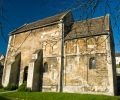Illustrated Dictionary of British Churches - Saxon Period Definition
History and Architecture
- Aisle
- Altar
- Ambulatory
- Angel Roof
- Apophyge
- Apse
- Arcade
- Arch
- Archivolt
- Base
- Battlement
- Bay
- Belfry
- Bell Tower
- Bellcote
- Bench End
- Board Bell Turret
- Body
- Boss
- Box pew
- Bracket
- Broach Spire
- Buttress
- Canopy
- Capital
- Cartouche
- Chancel
- Chancel Arch
- Chancel Screen
- Chantry
- Chapel
- Chapter House
- Choir
- Clerestory
- Cloister
- Communion Rail
- Compound Column
- Consecration Cross
- Corbel Head
- Crossing
- Crypt
- Early English
- Easter Sepulchre
- Effigy
- Fan Vaulting
- Font
- Font cover
- Funerary Helm
- Gallery
- Gargoyle
- Gothic
- Green Man
- Grotesque
- Hatchment
- Herringbone
- Hogback Tomb
- Holy Water Stoup
- Hunky Punk
- Jesse Window
- Kempe Window
- Lady Chapel
- Lancet
- Lectern
- Lierne
- Lych Gate
- Misericord
- Monumental Brass
- Mullion
- Nave
- Ogee
- Organ
- Parclose Screen
- Parish Chest
- Pendant
- Perpendicular Gothic
- Pew
- Pinnacle
- Piscina
- Poor Box
- Poppy Head
- Porch
- Priest's Door
- Pulpit
- Purbeck Marble
- Quire
- Rebus
- Reliquary
- Reredos
- Retable
- Romanesque
- Rood
- Rood Loft
- Rood screen
- Rood Stair
- Rose Window
- Round Tower
- Sanctuary
- Sanctuary Knocker
- Saxon Period
- Scratch Dial
- Sedilia
- Spire
- Statue Niche
- Stoup
- Tomb Recess
- Tracery
- Transept
- Triforium
- Tympanum
- Undercroft
- Vaulting
- Victorian Gothic
- Wall Monument
- Wall Painting
- Wheel Window
Saxon Period
Very loosely speaking, the Saxon period covers the time from the collapse of the Roman presence in Britain at the start of the 5th century until the Norman invasion in 1066. The term is sometimes used interchangeably with 'Dark Ages'. The Saxon period in church hiistory and architecture can be narrowed to loosely the 7th century until the Norman invasion.
Characteristics of Saxon church architecture:
- Narrow door and window openings
- Doors feature rectangular lintels or simple rounded arches
- Windows are sometimes framed by a stones forming a triangular lintel, or are simple vertical slits with a rounded top arch
- High walls
- 'Long and short work' stone corners (alternating horizontal and vertical corner stones)
- Herringbone stonework (diagonal courses of stones laid in alternating rows)
- Pilaster strips - long strips of vertical stone, often found decorating exterior walls
Many of the largest and most important later Saxon churches were rebuilt in Norman style after the Conquest, so our best examples of late Saxon work survive in smaller churches, such as St Lawrence, Bradford-on-Avon, and Boarhunt, Hampshire. These late Saxon churches were extremely simple in layout; a simple nave divided from a rectangular chancel by a narrow arch.
For further information see our article on Saxon architecture.
Related: Arch Chancel Nave Herringbone

Earls Barton, Northamptonshire







